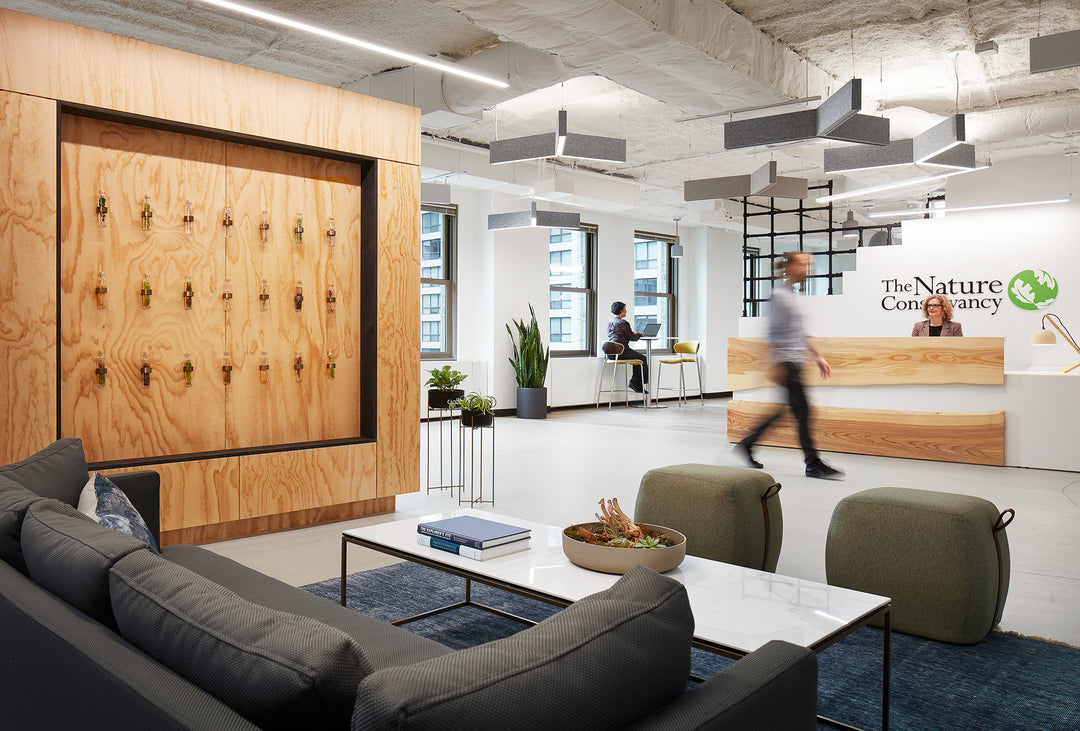Factors Affecting an Office Layout
Updated June 18, 2024, by Andy Svalesen, New Business Development. Originally published September 3, 2020.
The Importance of Office Planning and Layout Design
If you are planning an office move or just want to reorganize things, it's important to be aware of these factors affecting office layouts to ensure efficiency and productivity. A well-thought-out space can significantly boost employee morale and satisfaction. The office layout should adequately accommodate the number of employees, be adaptable to your business’s needs, and reflect the company culture. For a growing business, office design is essential and more viable than relocating frequently. Collaborating with professional interior designers, such as our design and planning experts at Rework, can be highly beneficial. As you begin planning, consider these critical factors for optimizing your office layout.
What are the Top Factors Affecting Office Layouts and Design?
Employee Privacy
Different people employ varied work styles. Some employees truly value having their own space and privacy. The open office concept fosters spontaneous interactions and teamwork, enhancing collaboration and communication. However, it can sometimes lead to an environment where people talk less and resort to silence or digital communication. That’s why balancing open office layouts with the need for privacy is essential. Innovative solutions like attachable, curved enclaves (such as the Teknion Smooth Felt Hoodie), height-adjustable privacy screens with frosted glass or plexiglass, short-duration use PODs, and sound-absorbing materials can help.

For instance, using mounted screens, modular architecture, or freestanding space dividers (such as EverySpace® by Kimball International and Lochlyn® by National) provide the necessary privacy and support for deep work while maintaining an open feel for the overall office. These office space planning elements allow you to create a versatile office environment supporting collaboration and individual work preferences.
Square FootageOne of the most significant factors affecting office layouts is the available space. When square footage is limited, working within those constraints is essential. While sprawling offices with tens of thousands of square feet offer the flexibility to arrange furniture freely, smaller offices demand strategic choices in the size and shape of the furniture to utilize the space effectively.
Maximizing limited office space is challenging, but one way to ensure employees get what they need in any size space is to involve them in the design process. Conducting employee surveys and ergonomic assessments helps determine the best layout and furniture choices. For example, in some cases, we found that smaller, collaborative spaces were more effective than large cubicles, leading to an emphasis on communal furniture pieces and the implementation of layouts designed to foster teamwork. In other situations, employees needed more storage and organization, making mobile pedestals or vertical shelving ideal smart storage solutions. Each workspace and employee has unique needs, requiring tailored design approaches. Gathering consistent employee feedback can lead to continuous improvement and higher satisfaction levels.

Flow in the Office
In any office, activity abounds. People move in and out of the space all day long. Inviting reception areas, entryways, and thoughtfully designed first impression areas are crucial for welcoming clients and visitors, setting a positive tone from the moment they enter. Creating walkways that provide direct paths is vital for safety and ensuring ADA compliance. Maintaining flow is crucial in office planning and layout. Clear pathways and access to natural light are essential. Using vertical planters and mobile presentation structures can help define zones within the office while nurturing biophilia and allowing natural light to permeate the space, creating a healthier and more comfortable environment for employees.
Arranging furniture to create unobstructed paths and using vertical storage solutions help maintain an open and airy feel. Ensuring that similar tasks are grouped together can also enhance workflow efficiency. Additionally, leaving parts of the office open to provide uninterrupted lines of sight out of the windows can prevent the space from feeling cramped, contributing to an overall welcoming environment.

Residential Comfort and Amenities
Attracting top talent is a priority for every hiring manager. Nowadays, potential employees seek more than just high pay and good benefits; they seek a comfortable work environment with added features. Workplace amenities are vital for employee satisfaction and retention. Providing comfortable furniture, quiet zones, wellness features, and recreational spaces is essential when designing office space layouts to enhance well-being and efficiency significantly. For example, Rework can conduct ergonomic assessments can help determine the ideal seating for employees, further enhancing their comfort and productivity when they come to the office. Additionally, incorporating meditation spaces or cushioned seating can promote comfort alongside productivity, creating a balanced and appealing work environment. Having designating areas for lounge activities, such as reading nooks and board game tables, and ensuring an inviting cafe area can further enhance the workplace atmosphere.

Acoustical Comfort & Sound Management
Another critical aspect of modern office space design and layouts is acoustic design, which addresses noise management to create a quieter, more productive environment. Adaptable design elements such as demountable wall systems provide comprehensive acoustic performance and a clean aesthetic, integrating various glass configurations for modern workspaces. These systems offer acoustic and visual continuity with matching wall and door pairings, minimal architectural presence, and a tailored fit for specific environments. At Rework, we offer comprehensive services that include sound management and acoustic solutions to ensure your office space meets all your functional and aesthetic needs.
Flexibility of SpaceFlexibility is critical in today's business environment. As workspaces evolve, the ability for an office space to adapt becomes vital. Building walls and permanent structures in the space will limit what you can do in the future. Flexibility is critical in today's business environment. Using adaptable design elements like moveable furniture, modular partitions, and nesting tables can create a versatile workspace. Use modular partitions to separate spaces and keep things interchangeable so the office can change and evolve. Ensure your office layout supports video conferencing setups, ample charging stations, casual power posts, and versatile mobile worktools with battery packs, allowing employees and guests to stay connected wherever they are in the office, enhancing productivity and connectivity. These elements allow the office to grow and accommodate changing needs, promoting a dynamic and flexible work environment.
An innovative approach to flexible space is the concept of "living labs." These are adaptable, multi-use spaces designed to test and implement new ideas and technologies in a real-world setting. Living labs can be reconfigured to suit various needs, from collaborative brainstorming sessions to quiet individual work, fostering a cohesive workplace environment. These flexible spaces are an excellent addition to a modern, adaptable office space.
Trends and the Future of Office Layout Design
As businesses continue to evolve, so too do the trends in office layout design. Here are some key trends shaping the modern office environment:
- Hybrid Workplaces: Driven by the increased demand for environments that blend in-office and remote work, hybrid workplaces are becoming increasingly popular. Flexible seating arrangements, hot-desking, and collaboration and huddle zones are common features.
- Biophilic Design: This trend incorporates elements of nature such as indoor plants, raised planters between desks, green walls, and natural light into the workspace. Biophilic design promotes well-being and productivity by creating a more pleasant and healthy work environment.
- Smart Office Technology: Integrating technology like automated lighting, climate control, and desk booking systems is growing in popularity as a way to enhance efficiency and convenience in the workplace. Some workspaces even have individual battery packs for flexible movement throughout the office.
- High Tech Design Innovation: Architecture and design firms are beginning to use heat mapping to identify the most and least used office areas, assess comfort levels, and address issues like noise. These data-driven design support services help create more efficient and comfortable workspaces.
- Wellness-Centric Design: There is a growing focus on incorporating health and well-being features such as wellness rooms, meditation spaces, new mothers' rooms, and fitness areas to boost employee satisfaction and retention.
- Sustainable and Eco-Friendly Designs: Companies increasingly use recycled materials, energy-efficient systems, and sustainable furniture options to create environmentally conscious workspaces. The blend of new and used office furniture allows for unique pieces and pops of color, making the office space special and memorable while staying within budget and reducing the carbon footprint.
By staying informed about these trends and considering them in your office layout planning, you can create a future-proof workspace that meets the evolving needs of your business and employees. Choose preowned, refurbished office furniture from Rework at up to 70% off list prices, to free up your design and layout budget for these essential amenities and innovative solutions. Rework is your home for the best used and refurbished office furniture nationwide. For expert advice on office planning and layout optimization and to explore our wide selection of used and refurbished office furniture, contact us today to schedule a visit to our furniture showroom or book a virtual design appointment. Let our teams help you create a productive and appealing workspace tailored to your needs.
 With 15 years of industry experience, Andy enjoys taking a collaborative approach with each project and spends time educating his clients about Rework's creative, cost-effective furniture offerings. Working closely with project stakeholders enables Andy to help provide innovative concepts that work for each project’s specific goals, aesthetic, and budget.
With 15 years of industry experience, Andy enjoys taking a collaborative approach with each project and spends time educating his clients about Rework's creative, cost-effective furniture offerings. Working closely with project stakeholders enables Andy to help provide innovative concepts that work for each project’s specific goals, aesthetic, and budget.
A team player at heart, Andy leverages the team's collective knowledge with Rework's vast network of vendors and technology to ensure each new space creatively and efficiently comes to life. Passionate, adaptive, and client-focused, Andy’s ethos centers on his clients’ success.




